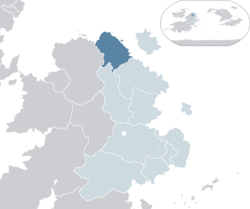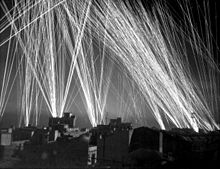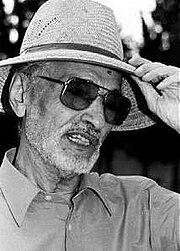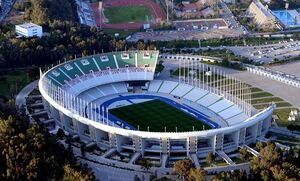Sabaw
This article is incomplete because it is pending further input from participants, or it is a work-in-progress by one author. Please comment on this article's talk page to share your input, comments and questions. Note: To contribute to this article, you may need to seek help from the author(s) of this page. |
Sabawi Republic
| |
|---|---|
| Motto: Tadkuli, Tasalayki, Teddu, (Sabawi) ("Union, Secularism, Progress") | |
| Anthem: Tagallit (English: "Oath") | |
 Sabaw (dark blue) in Bahia (light blue). | |
| Capital | Saab |
| Largest city | Nedrohari |
| Official languages | |
| Ethnic groups | |
| Religion |
|
| Demonym(s) | Sabawi |
| Government | Unitary semi-presidential republic |
| Bekathen Sadek | |
• Premier | Yaghmurasen Azam |
| Azuz Taha | |
| Syphax Waheed | |
| Afaw Salah | |
| Legislature | Senate |
| National Council | |
| National Assembly | |
| Independence from Estmere | |
| Area | |
• Total | 554,392 km2 (214,052 sq mi) |
| Population | |
• 2023 estimate | 38,282,949 |
• 2014 census | 34,748,388 |
• Density | 62/km2 (160.6/sq mi) |
| GDP (PPP) | 2022 estimate |
• Total | |
• Per capita | |
| GDP (nominal) | 2022 estimate |
• Total | |
• Per capita | |
| Gini (2022) | 30.6 medium |
| HDI (2022) | high |
| Currency | Sabawi Azref (TAR) |
| Time zone | UTC+2 (TST) |
| Date format | dd-mm-yyyy |
| Driving side | right |
| Calling code | +210 |
| Internet TLD | .ta |
Sabaw (Sabawi: ⵟⵙⴰⴱⴰⵡ, solarianized Tsabaw), officially the Sabawi Republic, and also occasionally known as Capria, is a country in North Bahia. It is bordered to the north by the Florian Sea, X to the east, Asase Lewa in the south, x in the south-east and Sohar in the east. It features the most northern point of Coius and is the second northernmost Irfanic-majority country after Sohar, geographically Sabaw sits in the relatively fertile northernmost region of Coius. The country has a land area of 554,392 km2 (214,052 sq mi), and has a population of approximately 38 million people. The capital of Saab sits in the Nedrohari metropolitan area on the north-eastern coast which is the most populous urban region in the country and one of the most populous in northern Coius. Other important urban areas include Tafrawt, Takhenanet, Tarudant, Aïn El Keghoud, Taddouf and Skikjel.
Sabaw has been continuously inhabited since the neolithic from which the earliest evidence of human inhabitation dates back to. Between 5000–3000 BC the emergence of Proto-Sabawi languages and the first early Caprian civilisations was recorded and had a profound impact on north-east Bahia. The rise of the Tarudant Empire saw much of the north-east first unified into a singular state and the spread of Sabawi culture and language throughout the empire, at its peak Tarudant was able to compete with the Solarian Empire and the Anniseran Empire in the region until its collapse in large part due to the simultaneous rapid growth of the Alypian Church and Irfan in the area. The area was subsequently divided into numerous independent states and dynasties which fought several religiously motivated wars between each other in the first millennium. An uneasy peace between the Irfanic dynasties and the coastal Sotirian states was formed after a sustained failure by the Irfanic dynasties to hold the northern coast although relations remained strained at best. Sabaw was first unified under the thalassocratic Uqdis who were successful in taking control of the Sotirian states in the north and uniting the various Irfanic dynasties via conflict. Uqdis had established a very successful trading network around the Bahian and Rahelian coastlines and had contacts with peoples in the Maccan Sea and the Gulf of Parishar at its peak, at the same time Uqdis had established trading relations with various Euclean states which remained uneasy due to the forced conversions and oppression faced by the Sotirians in Uqdis at several points in their relationship. The rise of Piracy around the northern coast and continued religious conflict weakened Uqdis which fell into a steep decline and was later largely integrated into the Khalji Sultanate with the exception of the primarily Sotirian north coast.
The establishment of the Saab dynasty in 1652 by Iles I marked the first officially recognised Sabawi state, the Saab were successful in weakening piracy in the area which was harming its surviving trade networks with Euclea and Bahia. The Seizure of Taddouf in 1846 and the subsequent Treaty of Skikjel and death of Daris III marked the end of the independence of the Saab which became an Estmerish protectorate. The Saab dynasty itself was abolished following the Caprian sucession crisis and replaced with a new nominally loyal Caprian regime. The removal from power and death of the sovereigntist Caprian President Autit Farooqui marked the end of total Estmerish control in the protectorate which became independent in 1952. The Taydemtist revolution between 1957 and 1960 brought Yeni Farooqui and the National Coordination Authority to power which initially aligned the officially neutral Sabaw with its leftist, secular neighbours although the unification of Zorasan as well as the Anniserian War saw Sabaw align itself with Estmere. Between 1999 and 2006 the country was governed by Azenzâr Farid who resigned under military and international pressure at the peak of the Sabaw Crisis. Since the establishment of the 30th of October regime Sabaw has been politically dominated by Bekathen Sadek who has served as President from 2006 until the present with an intermission between 2015 and 2018, the country under Sadek has experienced accusations of democratic backsliding and a failure to uphold human rights by the opposition and international community.
Since 2006 the country has been a unitary semi-presidential republic and officially is a secular state although the majority religion is Irfan with a significant Sotirian minority which is heavily localised on the northern coast. The country's official and most commonly spoken languages are Sabawi and Estmerish. Sabaw is considered a regional power in north Coius, it has the largest economy in Bahia in terms of nominal GDP as well as GDP per capita, Sabaw also has the highest Human Development Index in Bahia and has seen consistent moderate economic growth since 2004. The Sabawi diaspora is one of the largest globally with approximately 9–13 million members across the world. Sabaw is a member of several multinational organisations such as the Congress of Bahian States, Community of Nations, International Council for Democracy, International Trade Organization, Council for Mutual Development, Irfanic Cooperative Conference and the Estmerish Community.
Name
- Sabaw/Tsabaw from the Tsabaw river
- Capria and continued use of Capria internationally. Comes from the ancient city of Capra named by the Solarians
- Tsighawt domestically sometimes
History
Prehistory
Tarudant Empire
Fall of the Tarudant
Religious conflicts
Kingdom of Uqdis
Piracy
Khalji subservience
Saab dynasty and unification
Estmerish protectorate
Protectorate of Saab
Republic of Capria

In 1901, Yafu Saab deposed his brother and declared himself King of Sabaw sparking the Caprian succession crisis. His reign lasted 11 months until the Estmerish fleet threatened to bombard Takhenanet, subsequently Yafu was taken captive by the Estmerish navy and abdicated. King Yufthen I was also prohibited from returning to Capria but was allowed to retain his possessions and funded lifestyle in Estmere. Subsequently, the colonial authorities declared the creation of the Caprian Republic which was nominally loyal to Estmere as a protectorate under the Treaty of Skikjel. The Republic gained a new Estmerish written constitution in 1903 which established a semi-autonomous parliamentary republic led by President Makus Habib.
Habib's tenure as President focues on improving ties between Irfanics and Sotirians following the Tafrawt pogrom which killed an estimated 500 Sotirians and displaced thousands more. An increased Estmerish garrison was stationed in Capria following the events to quell any subsequent demonstrations related to the pogrom. Fearing further unrest Habib was pressured into forcing Irfanic and Sotirian officials into signing the Tafrawt Memorandum to reduce inter-communal violence and expand the powers of the High Commissioner in intervening in religious matters.

In 1912 the Nedrohari–Amizmiz railroad was completed to connect the port of Nedrohari to the Amizmiz plains which was the most fertile region of Capria and known as the breadbasket of Rahelia by colonial authorities. The opening of the railroad was the brainchild of Prime Minister of Estmere Herbert Maxwell who opened the railroad to traffic on the 18th of May 1912. Estmerish colonial authorities began selecting Caprian children who showed talent to be educated in Estmere so as to eventually foster Estmerophilic beliefs and create a new civil service class to better run the Protectorate. Many wealthier Caprians particularly from the former nobility and business leaders followed suit. The increased movement of ethnic Sabawis across the Gulf of Assonaire as a result became the known as the Sabawi diaspora and was key in reducing intercommunal tensions between Irfanics and Sotirians who both faced discrimination in the metropole and would eventually return to Sabaw. The policy worked well as the new Estmerish educated groups did observe typically more pro-Estmerish beliefes and attitudes than their compatriots and began to form a new middle class of business leaders and bureaucrats.
Politically Capria remained divided, most continued to oppose Estmerish rule. In the 1927 general election for the new President and Senate — a body that had extremely limited powers in the face of the High Commissioner — the Senate was nearly equally split between the Estmerophilic Rally of Independents who whilst arguing for a gradual independence and closer ties with Estmere were supportive of the High Commissioner and had their support amongst the Sotirian Community and the local elite. However the National Union which was more pro-independence than the Rally emerged as the victors and Autit Farooqui became President.
Whilst promising to work with the High Commissioner, Farooqui's already limited powers were almost immediately stripped by the Rally controlled Senate with support from the High Commissioner and Morwall. Farooqui's own growing interest in Functionalism and the development of Taydemtism which was labelled as a Functionalist-adjacent ideology by colonial authorities, saw him and his government face rapidly rising resentment from the Estmerish authorities and the Senate he was suspended from his position pending removal when the Great War broke out and interest in Capria from Morwall diminished due to the war. The Senate kept Farooqui suspended although was unable to impeach him and the High Commissioner, unwilling to inflame tensions, did not remove him from his position instead opting to try and convince Farooqui to support the war effort and introduce conscription of Sabawis for industrial production and to fight in Tsabara.

In the immediate aftermath of the Fall of Morwall, the Caprian protectorate remained nominally loyal towards the new government led by Wolfgar Godfredson. After Gaullican air raids on Estmerish naval bases Farooqui was imprisoned and the government was dissolved and re-established with the President of the Senate, Fiden Saah, becoming acting President. During Farooqui's imprisonment his health deteriorated until his death in custody in 1933 which prompted international calls for concern regarding the situation of the remaining political prisoners who were freed in the aftermath.
The death of Farooqui was a source of embarrassment for Estmere and whilst his death was attributed to natural causes – namely an aggressive skin cancer – Estmere was still blamed in Capria for his death. President Saah openly condemned the authorities for his death in his Yennayer speech to the Senate floor which was the first time a Caprian leader openly condemned the Estmerish authorities. Estmere refused to accept responsibility for Farooqui's death and colonial authorities began censorship of pro-Farooqui and National Union newspapers and radio broadcasts.
Over the succeeding decade it became increasingly clear that Estmere's colonial empire was failing and the abolishment of the monarchy in Estmere in the 1930s combined with the election of a new Socialist government in Morwall in 1941 marked a continued decline in Estmerish authority in the area. Whilst local leaders were at the moment content with gradual independence the slow pace of negotiations angered some including the newly founded Taydemt Front who advocated for immediate independence from Estmere and was led by the brother of Autit Farooqui, Yeni Farooqui. Independence negotiations formally began onboard the same Estmerish naval vessel which hosted King Yafu's abdication 40 years prior.
Independence from Estmere
Democratisation
Modern history and instability
Sabaw Crisis and coup
Presidencies of Bekathen and Yamina Sadek
Geography
Climate
Biodiversity
Politics and government
Foreign relations
Judiciary
Military
Administrative divisions
Human rights
Economy
Agriculture
Energy
Infrastructure
Transport
Labour market
Science and technology
Demographics
Religion
Language
Healthcare
Education
Culture
Architecture
Literature
Music
Media
Cinema first emerged in Sabaw during the reign of King Yufthen I with the first film shot in Sabaw – 'The Grand Corsair' – being released in 1901. Initially cinema was used as a propaganda tool by Estmerish colonial authorities with most films painting Estmerish influence in a positive light, most films during the colonial period were produced and directed by Estmerish filmmakers and many early films were produced for an emerging Estmerish audience. Sabaw became a popular destination for Estmerish filmmakers during the colonial period with dozens of films being filmed in the country prior to independence. The first Sabawi film, 'Caprian Girl' was produced and directed in 1946 was a critical success domestically and abroad. Sabaw has won the Béco aùreo twice, for 'King Daris' (1969) and 'List 1' (2000), both having been produced and directed by Sabawi-Etrurian filmmaker Djana Raffa, List 1 first premiered at the Montecara Film Festival two weeks after Raffa's death.
The Sabaw National Press Authority (SNPA) is the Sabawi state-ran national press agency and broadcaster which was created in 1952 after the Treaty of Aïn El Keghoud granted independence to Capria. The SNPA officially manages all publicly owned television networks and radio stations, by law all public mass media must be a SNPA subsidiary or affiliate. Three out of the four most watched television channels in Sabaw are affiliated in some way with the SNPA: Sabaw Channel One, Yuker Channel, Meddel and their affiliate channels together control 60% of the total share of regular television viewers in Sabaw which has led to criticisms about media freedom in Sabaw due to the SNPA's near total monopoly on the market. The Anzar Network is the largest privately owned television channel and the second largest channel by total viewership in Sabaw, in 2013 the Anzar Network alongside several other independently operated television channels were bought by the pro-government BMTV+ group.
Print media remains relatively diverse compared to the television market, in 2009 an estimated large or medium sized newspapers were operating in Sabaw with the vast majority being independently ran or produced. Historically print media was also monopolised by the government and all newspapers were legally required to be owned by the SNPA until 1982 when media restrictions were relaxed and newspapers owned by the SNPA were largely sold to private companies. Despite a relaxation in censorship and state-mandated monopolies, it remains illegal to directly insult or defame a present or historical national politician, judicial figure or law which is punishable by a potentially unlimited fine or the seizure of assets. Between 2000 and 2009, there were nineteen cases brought against various newspapers or personalities under this law, this increased between 2010 and 2018 when there were 107 charges filed under existing censorship laws. The pro-government Aymis and anti-government Azarug are the two largest national newspapers in Sabaw.
Cuisine
Sport
Football is the most popular sport in Sabaw and is governed domestically by the Sabawi Football Federation which also oversees the Sabawi First Series (SFS) which is the most watched sporting tournament in the country. The SFS has 17 teams competing as of 2022 and the current champions of the SFS are Adelta Saab who also have won the most SFS tournaments since the tournament's founding in 1913. Both Adelta Saab and Aqerṣan are considered among the best football teams in Bahia having won (TBD multinational football championship) several times between them. Sabawi football teams have had a history of success in Bahia and north Coius and are regarded as amongst the best in the area. Some Sabawi footballers have gained fame internationally such as Badiden Ameen, Daris Othman, Tariq Yassin, Sotirian Hariri, Medghasen Abdou and Ayigig Salahuddin.
The Sabawi national football team qualified for the IFF Coupe du monde six times since its first participation in 1951, the team has qualified consecutively since 2003 with the only exception being the 2019 IFF Coupe du monde when they were knocked out during the qualifiers to Maucha. The team's best result at the Coupe du monde occurred in 2015 when the team reached the round of 16 for the first time, before being knocked out by Estmere in penalties with a total score of 3–2. The Sabaw women's national football team was founded in 1995 although has seen considerably less success and support compared to the men's team and women's football remains severely overlooked and underdeveloped in Sabaw. The team was forced to cease operations between 2004 to 2006 due to objections from Irfani clerics and Deputies. The Sabaw youth national football team has also seen considerable success internationally and most recently reached the finals of the 20XX IFF Youth Coupe du monde but were defeated ultimately.
Wrestling is another popular sport in Sabaw and has been traditionally played in the country for centuries. At the Invictus Games Sabaw has been historically successful in the wrestling category and has won several medals at previous games although failed to qualify during the 2022 Summer Invictus Games. Akziz Youssef is currently the most decorated active wrestler in the world having won 10 Invictus medals as of 2018. Boxing is another popular form of combat sport in Sabaw, other popular combat sports includes mixed martial arts and also Judo which was popularised in the late 20th century. Tennis, Swimming, and Track and field are also popular sports in Sabaw.
Sabaw has attended every edition of the Invictus Games since 1938 when it first attended as the Caprian Republic. Since its first attendance Sabaw has won 42 medals in total including seven gold medals. Sabaw has twice launched bids to host the Invictus Games, once in 1998 and again in 2030. If successful the bids would have marked the first time a Bahian country had hosted the Invictus Games. Sabaw has only once attended the Winter Invictus Games in 2011 when Taoua Rais finished fifth in the women's figure skating event, Rais was the only athlete sent by Sabaw during the games. Between 1962 and 1974 Sabaw participated in the Games of the Red Star as an associate state of the Association of Emerging Socialist Economies. However Sabaw won no medals at the Games and withdrew in 1974 over political disputes.







